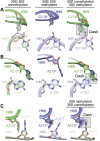Distant ribose 2'-O-methylation of 23S rRNA helix 69 pre-orders the capreomycin drug binding pocket at the ribosome subunit interface
- PMID: 40626557
- PMCID: PMC12235517
- DOI: 10.1093/nar/gkaf618
Distant ribose 2'-O-methylation of 23S rRNA helix 69 pre-orders the capreomycin drug binding pocket at the ribosome subunit interface
Abstract
Loss of ribosomal RNA (rRNA) modifications incorporated by the intrinsic methyltransferase TlyA results in reduced sensitivity to tuberactinomycin antibiotics such as capreomycin. However, how rRNA methylation alters drug binding, particularly at the distant but functionally more important site in 23S rRNA helix 69 (H69), is currently unknown. We determined high-resolution cryo-electron microscopy structures of the Mycolicibacterium smegmatis 70S ribosome with or without the two ribose 2'-O-methyl modifications incorporated by TlyA. In the unmodified ribosome, the tip of H69 adopts a more compact conformation, positioning two key nucleotides (A2137 and C2138) such that interactions with capreomycin would be lost and the binding pocket partially occluded. Methylation of 23S rRNA nucleotide C2144 promotes conformational changes that result in a more favorable positioning of C2138 and adoption of a more open conformation to enable capreomycin binding. Molecular dynamics simulations and H69 RNA helical analyses additionally reveal specific propagation of these changes from the site of modification to the H69 tip, allosterically reconfiguring the capreomycin binding site. Methylation of h44 also results in structural rearrangements at the H69-h44 interface to support maintenance of these changes that favor antibiotic binding. This work thus reveals the effect and regulation of distant rRNA methylation on ribosome-targeting antibiotic binding.
© The Author(s) 2025. Published by Oxford University Press on behalf of Nucleic Acids Research.
Conflict of interest statement
None declared.
Figures







Update of
-
DISTANT RIBOSE 2'-O-METHYLATION OF 23S rRNA HELIX 69 PRE-ORDERS THE CAPREOMYCIN DRUG BINDING POCKET AT THE RIBOSOME SUBUNIT INTERFACE.bioRxiv [Preprint]. 2024 Nov 5:2024.11.05.619916. doi: 10.1101/2024.11.05.619916. bioRxiv. 2024. Update in: Nucleic Acids Res. 2025 Jul 8;53(13):gkaf618. doi: 10.1093/nar/gkaf618. PMID: 39574593 Free PMC article. Updated. Preprint.
Similar articles
-
DISTANT RIBOSE 2'-O-METHYLATION OF 23S rRNA HELIX 69 PRE-ORDERS THE CAPREOMYCIN DRUG BINDING POCKET AT THE RIBOSOME SUBUNIT INTERFACE.bioRxiv [Preprint]. 2024 Nov 5:2024.11.05.619916. doi: 10.1101/2024.11.05.619916. bioRxiv. 2024. Update in: Nucleic Acids Res. 2025 Jul 8;53(13):gkaf618. doi: 10.1093/nar/gkaf618. PMID: 39574593 Free PMC article. Updated. Preprint.
-
HflX-mediated drug resistance through ribosome splitting and rRNA disordering in mycobacteria.Proc Natl Acad Sci U S A. 2025 Feb 11;122(6):e2419826122. doi: 10.1073/pnas.2419826122. Epub 2025 Feb 6. Proc Natl Acad Sci U S A. 2025. PMID: 39913204 Free PMC article.
-
50S subunit recognition and modification by the Mycobacterium tuberculosis ribosomal RNA methyltransferase TlyA.Proc Natl Acad Sci U S A. 2022 Apr 5;119(14):e2120352119. doi: 10.1073/pnas.2120352119. Epub 2022 Mar 31. Proc Natl Acad Sci U S A. 2022. PMID: 35357969 Free PMC article.
-
The Black Book of Psychotropic Dosing and Monitoring.Psychopharmacol Bull. 2024 Jul 8;54(3):8-59. Psychopharmacol Bull. 2024. PMID: 38993656 Free PMC article. Review.
-
Maternal and neonatal outcomes of elective induction of labor.Evid Rep Technol Assess (Full Rep). 2009 Mar;(176):1-257. Evid Rep Technol Assess (Full Rep). 2009. PMID: 19408970 Free PMC article.
References
MeSH terms
Substances
Grants and funding
- R01 AI088025/AI/NIAID NIH HHS/United States
- T32 AI106699/AI/NIAID NIH HHS/United States
- U24 GM129539/NH/NIH HHS/United States
- T32-AI106699/NH/NIH HHS/United States
- SF349247/Simons Foundation
- Burroughs Wellcome Fund Investigator
- T32-GM008602/NH/NIH HHS/United States
- Simons Electron Microscopy Center
- U24 GM129539/GM/NIGMS NIH HHS/United States
- R01-AI088025/NH/NIH HHS/United States
- Emory University Robert P. Apkarian Integrated Electron Microscopy Core Facility
- National Center for CryoEM Access and Training (NCCAT)
- T32 GM008602/GM/NIGMS NIH HHS/United States
LinkOut - more resources
Full Text Sources

